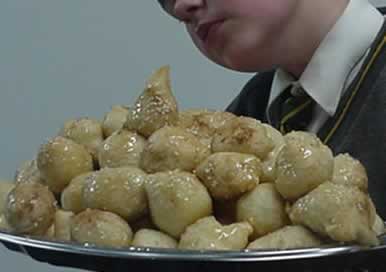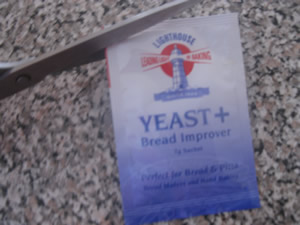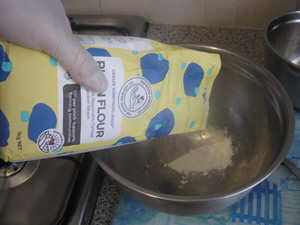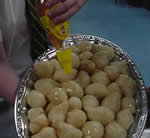Using yeast to make fermentation puffs.
Oil can reach temperatures well above 200 oC. This activity must only be done with adult supervision. Ask Mum or Dad to supervise.
Yeast cells undergo a process called fermentation. In this process special chemicals in the cells, called enzymes, break down sugar into alcohol and carbon dioxide. This chemical reaction releases heat energy which is why the dough mixture feels warm. The reaction can be written in a simple form:
sugar -----> alcohol + carbon dioxide + heat energy
Yeast cells contain special chemicals known as enzymes. Each enzyme has a specific function. One enzyme, for example, breaks down starch into sugar while another breaks down sugar into alcohol and carbon dioxide. These enzymes act to speed up chemical reactions in the yeast cell. Chemicals that speed up reactions are known as catalysts.
Enzymes work only in a certain temperature range which is why yeast must be kept in a warm place.

Lets put yeast
to work to make some delicious fermentation puffs.
You will need:
- A deep pot to fry the dough
- Olive oil (1 litre)
- Plain flour(1kg)
- Cinnamon
- Yeast
- Teaspoon of sugar and a pinch of salt
- Honey
- Sesame seeds.
- Table spoon and a spatula to scoop the puffs from the pot with the oil.


Step 1 Cut open a satchel of
dry yeast and empty it into a large mixing bowl.
Step 2 Add half a glass of warm (not hot) water.
Step 3 Add a teaspoon of sugar and a pinch of salt and stir until the mixture has a consistent look with no lumps in it.
Step 4 Put to one side for ten minutes to allow time for the yeast to activate.
Bubbles will start to appear on the surface, which is a good sign of active yeast.
Mix the yeast mixture carefully with your fingers until the yeast no longer clump together and the water looks brown and has a consistent appearance, view the video on the left.

Step 5 Add half the flour and half a cup of warm water to a large mixing bowl and stir thoroughly.
Cover the bowl with
a thick cloth to keep the dough warm.
After two hours you will notice that the dough mixture has risen. It is now full of gas bubbles and is very warm. If you wish to keep the dough to cook the next day place it in the fridge covered in GladWrap. Cooling the dough mixture will inactivate the yeast and stop the dough rising.
Time to now get the pot of oil ready. Place one litre of olive oil in the pot and set to a medium temperature. You do not want the oil to be too hot as the dough will cook quickly on the outside leaving the inside uncooked. Put some gloves on and lets go.
Oil can get to well over 200oC and can cause severe burns, children must never try this without adult supervision.
Step
6 Reach into the dough mixture and grab a hand full of dough. Dip the table spoon in oil. Squeeze
the dough in your hand until it comes out from top of your fist as shown
on the left. Scoop the ball of dough with the spoon and place it in the
pot with the oil.
Limit the size of every doughnut to about the size of a 50 cent piece or about 3cm in diameter. See the video on the left. This way they cook quicker, with a crispy coating and do not splatter oil as some of the bigger doughnuts do as they crack open. Small doughnuts are better. Keep in mind that they will expand as the fry.
Make as many dough ball as necessary making sure that there is enough separation on the surface of the oil for the balls to float without contacting each other.
Step 7 Reduce the heat now to low and cook until the puffs are starting to turn a light brown colour.
When finished, turn the hot plate off and allow the oil to cool.


Add cinnamon and sesame seeds as required..
Why is warm water used to prepare
the dough?
Why is sugar used as one of the ingredients?
What gas is present in the dough?
After fermenting for two hours the dough feels warm. Explain why the dough is warm?
What do you expect to happen if the dough was allowed to cool?
Why is it recommended that a thick cloth be placed over the dough mixture?
At warm temperatures the yeast thrive in the sugary mixture but when cold the yeast simply go to sleep and produce very little gas and alcohol.
Yeast feed on sugar which must travel from the surrounding mixture to the yeast in order to be used up. Use your knowledge of particle theory to explain why when placed in the fridge the dough mixture does not rise but when placed once more in a warm place the yeast thrive and produce carbon dioxide gas once more.